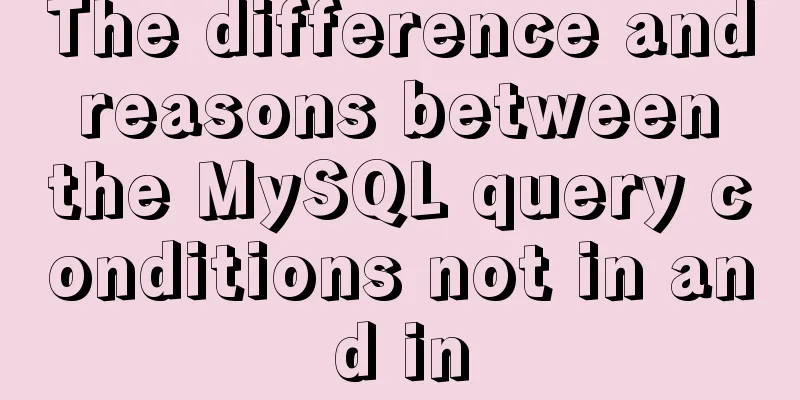The difference and reasons between the MySQL query conditions not in and in

|
Write a SQL first SELECT DISTINCT from_id FROM cod WHERE cod.from_id NOT IN (37, 56, 57) When I was writing SQL today, I found that the query results were incomplete, missing NULL values, and even excluded null when not in. When using in, it does not include null I feel that MySQL is not designed properly. Because I always thought that in and not in should complement each other, just like this should be the whole search: SELECT DISTINCT from_id FROM cod WHERE cod.from_id NOT IN (37, 56, 57) or cod.from_id IN (37, 56, 57) The result is as expected, there is a missing null Later I checked online and found a reasonable explanation: null is false when compared to any value For example, if from_id is (37, 56, 57,28,null), not in (37, 56, 57) is true when compared with 28, so 28 appears in the result set. When null is compared with the condition not in (37, 56, 57), the result is false, so it does not appear in the result set. Supplement: How to handle NULL values on both sides of MySQL conditional queries IN and NOT IN topicGiven a table tree, id is the number of the tree node, and p_id is the id of its parent node. +----+------+ | id | p_id | +----+------+ | 1 | NULL | | 2 | 1 | | 3 | 1 | | 4 | 2 | | 5 | 2 | +----+------+ Each node in the tree is of one of three types: Leaf: If this node does not have any child nodes. Root: If this node is the root of the entire tree, that is, it has no parent node. Internal node: If the node is neither a leaf node nor a root node. Write a query statement to output the numbers and types of all nodes, and sort the results by node number. The result of the above example is: +----+------+ | id | TYPE | +----+------+ | 1 | Root | | 2 | INNER| | 3 | Leaf | | 4 | Leaf | | 5 | Leaf | +----+------+ explain Node '1' is the root node because its parent is NULL and it has child nodes '2' and '3'. Node '2' is an internal node because it has a parent node '1' and also has child nodes '4' and '5'. Nodes '3', '4' and '5' are leaf nodes because they have a parent node and no child nodes. The tree in this example looks like this: 1 / \\ twenty three / \\ 4 5 First create the table 1. Create a table CREATE TABLE tree( id INT , p_id INT ) Here is how I do it: SELECT id,( CASE WHEN tree.p_id IS NULL THEN 'Root' WHEN tree.id NOT IN ( -- When id is not in the parent node p_id column, it is considered a leaf node, which is logically correct! SELECT p_id FROM tree GROUP BY p_id ) THEN 'Leaf' ELSE 'Inner' END )TYPE FROM tree I think that when the id is not in the p_id column of the parent node, it is considered a leaf node. There is no logical problem at all. However, things are not that simple. The query results are as follows: Starting from id=3, I did not find the results I wanted! Isn’t it amazing!
So after another night, I finally solved the problem. I will first give the correct approach: SELECT id,( CASE WHEN tree.p_id IS NULL THEN 'Root' WHEN tree.id NOT IN ( SELECT p_id FROM tree WHERE p_id IS NOT NULL -- Added a SQL statement GROUP BY p_id ) THEN 'Leaf' ELSE 'Inner' END )TYPE FROM tree
Why is this happening? it is known The IN operator in MySQL is used to determine whether the value of an expression is in a given list; if so, the return value is 1, otherwise the return value is 0. The function of NOT IN is exactly the opposite of IN. NOT IN is used to determine whether the value of the expression does not exist in the given list; if not, the return value is 1, otherwise the return value is 0. This is how we usually use it, and the result is what we want. But we often encounter the following special situations! (1) There are no NULL values on either side of in or not in[Example 1] Using IN and NOT IN operators in SQL statements: mysql> SELECT 2 IN (1,3,5,'thks'),'thks' IN (1,3,5, 'thks'); +---------------------+---------------------------+ | 2 IN (1,3,5,'thks') | 'thks' IN (1,3,5, 'thks') | +---------------------+---------------------------+ | 0 | 1 | +---------------------+---------------------------+ 1 row in set, 2 warnings (0.00 sec) mysql> SELECT 2 NOT IN (1,3,5,'thks'),'thks' NOT IN (1,3,5, 'thks'); +-------------------------+-------------------------------+ | 2 NOT IN (1,3,5,'thks') | 'thks' NOT IN (1,3,5, 'thks') | +-------------------------+-------------------------------+ | 1 | 0 | +-------------------------+-------------------------------+ 1 row in set, 2 warnings (0.00 sec) From the results, we can see that the return values of IN and NOT IN are exactly opposite. But I ignored the NULL value problem Handling of NULL values When either side of the IN operator is NULL, the return value is NULL if no match is found; if a match is found, the return value is 1. (2) NULL values are on both sides of inPlease see the following SQL statement: mysql> SELECT NULL IN (1,3,5,'thks'),10 IN (1,3,NULL,'thks'); +------------------------+-------------------------+ | NULL IN (1,3,5,'thks') | 10 IN (1,3,NULL,'thks') | +------------------------+-------------------------+ | NULL | NULL | +------------------------+-------------------------+ 1 row in set, 1 warning (0.00 sec) mysql> SELECT NULL IN (1,3,5,'thks'),10 IN (1,10,NULL,'thks'); +------------------------+--------------------------+ | NULL IN (1,3,5,'thks') | 10 IN (1,10,NULL,'thks') | +------------------------+--------------------------+ | NULL | 1 | +------------------------+--------------------------+ 1 row in set (0.00 sec) (3) NULL on one side of NOT INNOT IN is just the opposite. When one of the two sides of the NOT IN operator is a null value NULL, if no match is found, the return value is NULL; if a match is found, the return value is 0. Please see the following SQL statement: mysql> SELECT NULL NOT IN (1,3,5,'thks'),10 NOT IN (1,0,NULL,'thks'); +----------------------------+-----------------------------+ | NULL NOT IN (1,3,5,'thks') | 10 NOT IN (1,0,NULL,'thks') | +----------------------------+-----------------------------+ | NULL | NULL | +----------------------------+-----------------------------+ 1 row in set, 1 warning (0.00 sec) mysql> SELECT NULL NOT IN (1,3,5,'thks'),10 NOT IN (1,10,NULL,'thks'); +----------------------------+------------------------------+ | NULL NOT IN (1,3,5,'thks') | 10 NOT IN (1,10,NULL,'thks') | +----------------------------+------------------------------+ | NULL | 0 | +----------------------------+------------------------------+ 1 row in set (0.00 sec) Based on the result of (3) NULL on one side of NOT IN, we can see the problem Let's query the following SQL statement first and slowly find the problem SELECT p_id FROM tree GROUP BY p_id The above query results contain NULL values
So the following SQL statement will not find anything, because NOT IN returns NULL SELECT id FROM tree WHERE id NOT IN ( SELECT p_id FROM tree GROUP BY p_id )
So if you want to query the results, you must first deal with the NULL value! OK, the bug is fixed! There is another way to do this problem: SELECT id,( CASE WHEN tree.p_id IS NULL THEN 'Root' WHEN tree.id IN ( SELECT p_id FROM tree GROUP BY p_id ) THEN 'Inner' ELSE 'Leaf' END )TYPE FROM tree
Why is it right? Let's leave it for you to think about~ The above is my personal experience. I hope it can give you a reference. I also hope that you will support 123WORDPRESS.COM. If there are any mistakes or incomplete considerations, please feel free to correct me. You may also be interested in:
|
<<: Solve the problem of MySQL using not in to include null values
>>: XHTML tutorial, a brief introduction to the basics of XHTML
Recommend
How to modify Flash SWF files in web pages
I think this is a problem that many people have en...
Is a design that complies with design specifications a good design?
In the past few years of my career, I have writte...
How MySQL Select Statement is Executed
How is the MySQL Select statement executed? I rec...
Detailed steps to install a virtual machine and use CentOS 8 using VMware 15
Preface: I'm currently learning Linux and .Ne...
HTML+CSS div solution when relative width and absolute width conflict
Div solution when relative width and absolute wid...
Vue+spring boot realizes the verification code function
This article example shares the specific code of ...
Vue Element front-end application development conventional Element interface components
Table of contents 1. List interface and other mod...
Basic implementation method of cross-component binding using v-model in Vue
Hello everyone, today we will talk about how to u...
Sorting out some common problems encountered in CSS (Hack logo/fixed container/vertical centering of images)
1. IE browser mode Hack logo 1. CSS hack logo Copy...
Analyze several common solutions to MySQL exceptions
Table of contents Preface 1. The database name or...
Vue2 implements provide inject to deliver responsiveness
1. Conventional writing in vue2 // The parent com...
Implementation steps for building a local web server on Centos8
1 Overview System centos8, use httpd to build a l...
Example of how to set WordPress pseudo-static in Nginx
Quoting Baidu's explanation of pseudo-static:...
Building a Redis cluster on Docker
Table of contents 1. Pull the image 2. Create a R...
MySQL 8.0.15 winx64 installation and configuration method graphic tutorial under windows
This article shares the installation and configur...














